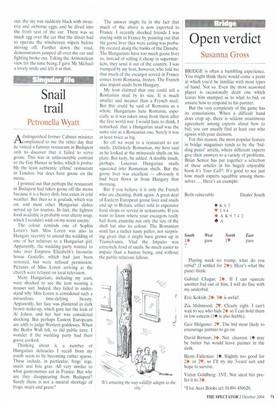Snail trail
Petronella Wyatt
Adistinguished former Cabinet minister complained to me the other day that he visited a famous restaurant in Budapest only to discover that it failed to serve goose. This was in unfavourable contrast to the Gay Hussar in Soho, which is probably the least authentic 'ethnic' restaurant in London. but does have goose on the menu.
I pointed out that perhaps the restaurant in Budapest had taken goose off the menu because it is a heavy dish, best eaten in cold weather. But then so is goulash, which was on, and most other Hungarian dishes served up for tourists. In fact, the lightest food available is probably sour cherry soup. which I wouldn't wish on my worst enemy.
The colour reminds one of Sophia Loren's hair. Miss Loren was also in Hungary recently to attend the wedding of one of her relatives to a Hungarian girl. Apparently, the wedding party wanted to take over Empress Elizabeth's favourite house Godollo. which had just been restored, but were refused permission. Pictures of Miss Loren arriving at the church were relayed on local television.
Many Hungarians, including my aunt, were shocked to see the icon wearing a trouser suit. Indeed, they failed to understand why Miss Loren is considered such a miraculous, time-defying beauty. Apparently, her face was plastered in dark brown make-up, which gave her the look of Al Jolson, and her hair was considered shocking. But perhaps Eastern Europeans are unfit to judge Western goddesses. When the Berlin Wall fell, so did public taste. I wonder if the wedding party had their goose cooked.
Thinking about it, a number of Hungarian delicacies I recall from my youth seem to be becoming rather sparse. These include, in particular, frogs' legs, snails and foie gras. All very similar to what gastronomes eat in France. But why are they disappearing from Budapest? Surely there is not a natural shortage of frogs, snails and geese? The answer might lie in the fact that much of the above is now exported to France. I recently shocked friends I was staying with in France by pointing out that the goose liver they were eating was probably created along the banks of the Danube. The Hungarians have too much goose liver so, instead of selling it cheap in supermarkets, they send it out of the country. I was trumped by my host, however, who told me that much of the escargot served in France comes from Romania, frozen. The French also import snails from Hungary.
My host claimed that one could tell a Romanian snail by its size. It is much smaller and meaner than a French snail. But this could be said of Romania as a whole. Hungarians hate Romania, especially as it was taken away from them after the first world war. I would hate to think, I remarked, that a Hungarian snail was the same size as a Romanian one. Surely it was at least twice as big.
So off we went to a restaurant to eat snails. Definitely Romanian, my host said as he looked at the minuscule shells on his plate. But tasty, he added. A double insult, perhaps. Luscious Hungarian snails squeezed into Romanian shells. But the goose liver was excellent — obviously it had been flown in from Hungary that morning.
But if you believe it is only the French who are cheating, think again. A great deal of Eastern European goose liver and snails end up in Britain, either sold in expensive food shops or served in restaurants. If you want to know where your escargots really hail from, examine not only the size of the shell but also its colour. The Romanian snail has a rather nasty pallor, not surprising given that it might have grown up in Transylvania. Vlad the Impaler was extremely fond of snails. So much easier to impale than a human being, and without the public relations fallout.


















































































 Previous page
Previous page